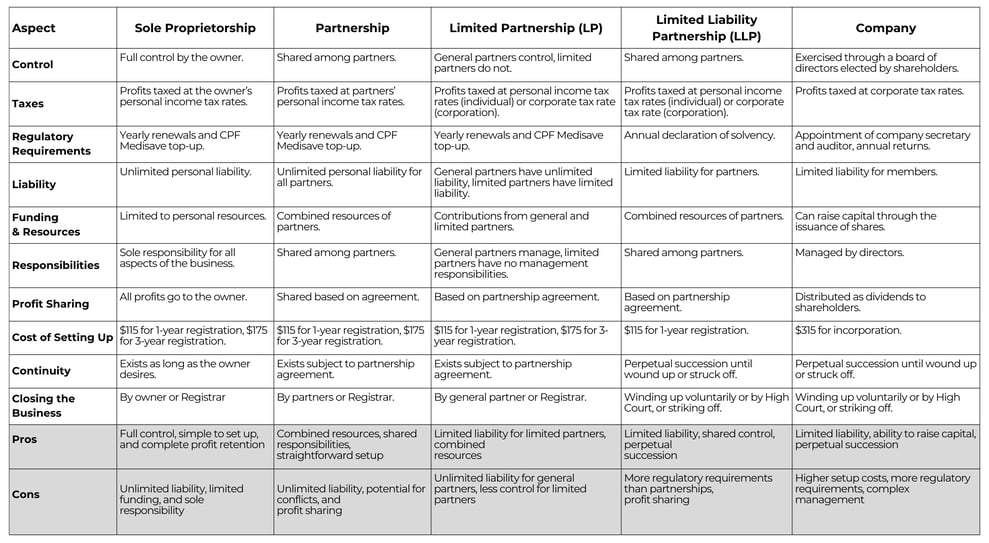Starting a business in Singapore is an exciting venture, but choosing the right business structure is crucial. Each structure has unique implications for control, taxes, regulatory requirements, liability, and more. Let us explore various business structures in Singapore and how they affect you as a business owner.
Topic: Different Business Structures in Singapore and How They Affect Business Owners
Choosing the right business structure can significantly impact how you operate and manage your business. Let’s dive into the different options available in Singapore and examine their advantages and disadvantages.
Business Structures in Singapore
1. Sole Proprietorship
In a sole proprietorship, the owner has full control over the business. Profits are taxed at the owner’s personal income tax rates. Regulatory requirements include yearly renewals and CPF Medisave top-up. The owner faces unlimited personal liability and funding is limited to personal resources. All responsibilities fall on the owner, who also retains all profits. The cost of setting up is $115 for a one-year registration or $175 for a three-year registration. The business exists as long as the owner desires and can be closed by the owner or Registrar.
2. Partnership
In a partnership, control is shared among partners. Profits are taxed at the partners’ personal income tax rates. The business requires yearly renewals and CPF Medisave top-up. All partners face unlimited personal liability. Funding comes from the combined resources of partners, who share responsibilities. Profits are shared based on the partnership agreement. The setup cost is $115 for a one-year registration or $175 for a three-year registration. The partnership exists as long as specified in the partnership agreement and can be closed by the partners or Registrar.
3. Limited Partnership (LP)
A limited partnership consists of general and limited partners, where general partners control the business and limited partners do not. Profits are taxed at personal income tax rates (for individuals) or corporate tax rates (for corporations). It requires yearly renewals and CPF Medisave top-up. General partners have unlimited liability, while limited partners' liability is limited to their contributions. Funding is provided by both types of partners. General partners manage the business while limited partners have no management responsibilities. Profits are shared based on the partnership agreement. Setting up costs $115 for a one-year registration or $175 for a three-year registration. The business continues as per the partnership agreement and can be closed by the general partner or Registrar.
4. Limited Liability Partnership (LLP)
In an LLP, control is shared among partners. Profits are taxed at personal income tax rates (for individuals) or corporate tax rates (for corporations). It requires an annual declaration of solvency. Partners have limited liability. Funding comes from the combined resources of partners. Responsibilities are shared among partners, and profits are distributed based on the partnership agreement. Setting up costs $115 for a one-year registration. The business enjoys perpetual succession until wound up or struck off and can be closed voluntarily or by the High Court.
5. Company
A company is controlled by a board of directors elected by shareholders. Profits are taxed at corporate tax rates. Regulatory requirements include appointing a company secretary and auditor, and filing annual returns. Members have limited liability. The company can raise capital by issuing shares. Management is the responsibility of directors. Profits are distributed as dividends to shareholders. Incorporation costs $315. The company has perpetual succession until wound up or struck off and can be closed voluntarily or by the High Court.
Summary with Pros and Cons




